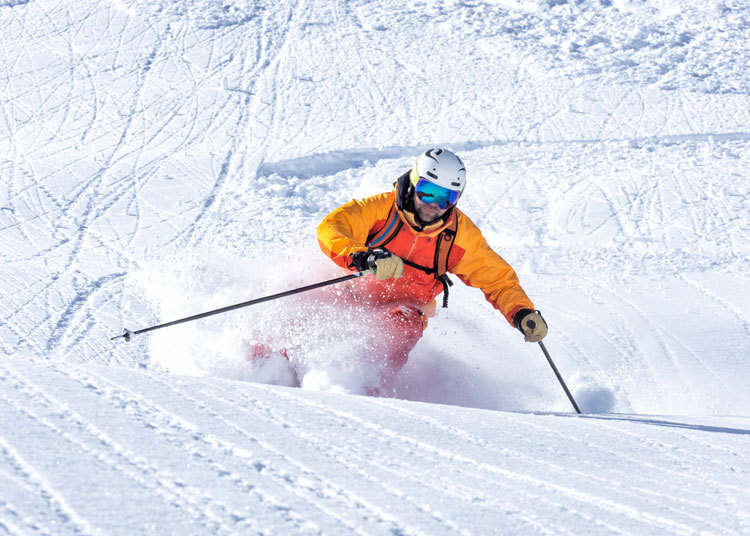
When planning your ski trip in Japan, even if you're a complete beginner, you're in for a treat. Japan is home to the world-famous powder snow, and the generally heavy amount of snowfall on the island nation makes it very conducive for winter sports of all kinds.
In fact, more and more foreign nationals are coming to Japan regularly for snow-related activities like skiing and snowboarding. Hokkaido is the destination that usually comes to mind when it comes to winter activities in Japan, but ski resorts in places such as Nagano and Niigata that are located near Tokyo city have become more and more popular recently as well.
For the best ski experience in Japan, here are a few things we recommend keeping in mind.
1) Understanding the different types of skis
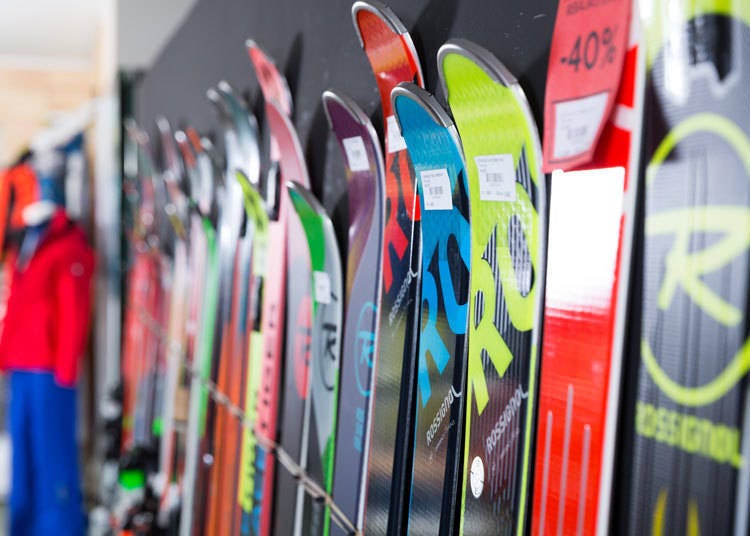
The type of skis you'll need depends on the type of skiing style you favor. Do you do alpine, freestyle, or something else - like rocker skis?
●Basic and alpine skis
Alpine skiing, known as the star of the Winter Olympics, is a type of high-speed downhill skiing where ski control can make or break the race, so skis for the sport are designed for maneuverability.
In competitions such as basic skiing, where points are given out for how accurately and rationally ski moves are executed, participants usually use competitive skis or skis modified for better maneuverability as well.
Skis designed to facilitate better turning, a ski technique that characterizes alpine or basic skiing are also widely available with a number of different models. Look up their differences and choose the one that suits your ski style best!
・Skis for large turns
The longer the ski, the wider its turning radius. This wide turning radius allows the skier to make long carves at high-speed without losing their balance.
To achieve this, men can go for skis that are roughly 180 cm (5'10") long and women can try skis with a length of about 175 cm (5'8"). Of course, further adjustments can be made according to your actual height.
Upper grade models are tougher to flex, so you'll need quite a lot of leg strength to manipulate them. Because these boards are so long, it's difficult to make smaller turns. However, they are the perfect boards to use to negotiate long turns on compact ski routes.
・Skis for small turns
Shorter skis have shorter turn radiuses and are most suitable for making small turns. The exact length of the ski will depend on your height, but should generally rest between 160 to 165 cm (5'2" to 5'4").
These skis do well in sharp carved turns or slow short turns and would be the best equipment for a skier who wants to go around the ski slope having full control of every twist and turn.
Since these skis are effective at making short turns, moguled slopes won't be a problem either. If you like, you can also use them to make medium turns, but to ensure stable footing, we would still recommend doing medium turns with skis tailored for long turns.
・Medium skis
Medium skis, typically measuring at a length between skis for long turns and short turns, are categorized as all-rounder skis that allow for both types of turns. The robust lineup consists of models for all levels - from the family-friendly to the veteran-preferred.
Because the sidecut on these skis aren't too deep, skiers can expect to have much fun using techniques other than carved turns! They're also suitable for ski powder and mogul skiing.
Ladies and minors who aren't too sure if they have enough leg strength for the regular models can choose skis with a softer flex for ease of control.
・Ski cross
This is a type of timed ski race where participants compete on a course with banks, rollers, and jumping platforms. Long skis are the standard equipment many competitors choose for this sport as it's quite a new competitive event and manufacturers have yet to create too many skis models optimized for it. Since these skis are stable in motion, they make high-speed long turns on a compacted snow slope absolute heavenly to execute!
●Freestyle skis
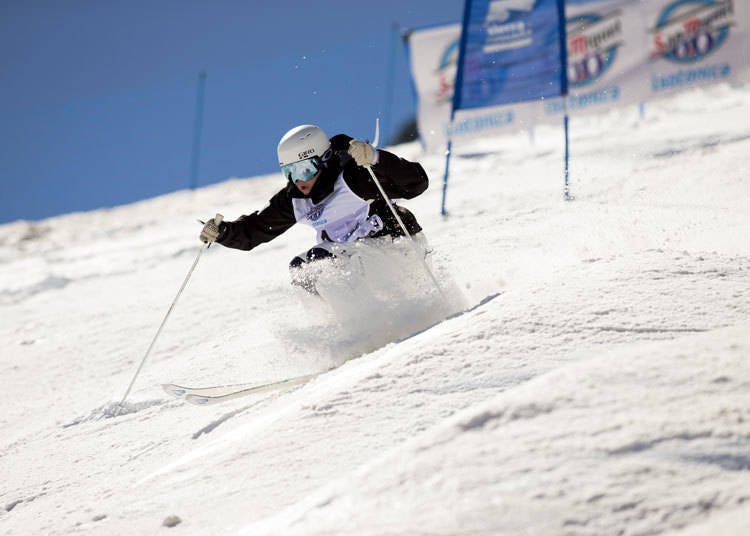
Freestyle skiing is a sport where veteran skiers employ all sorts of ski techniques, from mogul to park, powder, or a little bit of everything to create a distinct ski style unique to themselves. There is a wide range of ski models designed to accommodate each individual style.
・Mogul skis
These skis are longer, thinner, and have a gentler sidecut so as to allow the skier to navigate themselves over moguls directly. A moderate amount of flex and force on these skis will be enough to launch the skier into the air without much fuss.
・Half-pipe / Jump and jib
Skis designed for half-pipe skiing have a uniform flex throughout, making it easier to pump for acceleration. The tips and tails of jump and jib skis are softer and easier to land with. Both models of skis are suitable for park style skiing as well. Being fat skis, they offer great stability and repulsion force, which are essential traits for a satisfying park style half-pipe, kicker, or jib.
・Short skis (ski boards)
As the name suggests, these skis are on the shorter side, measuring less than 100 cm (about 39.3 inches) in length. They are excellent candidates for those desiring free movement on ski slopes. These skis don't tend to perform well in sharp carves, high-speed turns, or powder runs, but if you need something for narrow turns or kickers and half-pipes, you'll want these! At that length, they're also easy to rotate, making them suitable to be used as entry-level skis as well.
・Powder skis
Models that are optimized for maximum enjoyment on powder snow or ungroomed slopes mostly consist of rocker-shaped skis with large tip and tail curls. Because these versatile and powerful skis are longer and wider than regular skis, they perform well even on off-piste terrain.
●Rocker skis

The most distinct characteristic of rocker skis is that they are shaped to ensure as little contact with the snow as possible when stepped on. This means they will feel more buoyant than regular skis. Plenty of models for this type of skis have already been released, including models suitable for terrains like compacted slopes, park skiing, and competitive races.
・Tip rockers
These skis are rocker-shaped only at the tips, giving them better control during the first half of a turn. The longer the rockers, the easier it is to change edges or rotate skis. On the other hand, the shorter the rockers, the easier it is to hold onto a position or execute a sharper turn.
・Twin rockers
Twin rockers are skis that have rockers on both tips and tails, and most freestyle models are designed for skiing backwards (switching) as well. These skis are shaped in such a way that the skier can enter a jib object stably while switching or from a kicker. The ease of control is one of the ski's features, and it can be used to perform spins quite comfortably as well.
・Powder rockers
With rockers that go all the way up to the bindings, these skis are optimized for powder runs. The buoyancy is what attracts powder skiers to these skis, since they make for bouts of fun and powerful off-piste skiing. On the other hand, this also means they are not suitable for groomed or icy slopes.
・Full rockers
Full rocker skis are rockers from tip to tail, with not a single inch of camber in sight. Since both tips and tails are curled upward, butter-smooth rotations are within the realms of possibility. The edges don't hold very well, but the skis are great at executing quick movements without being affected by surrounding conditions.
●All-mountain skis
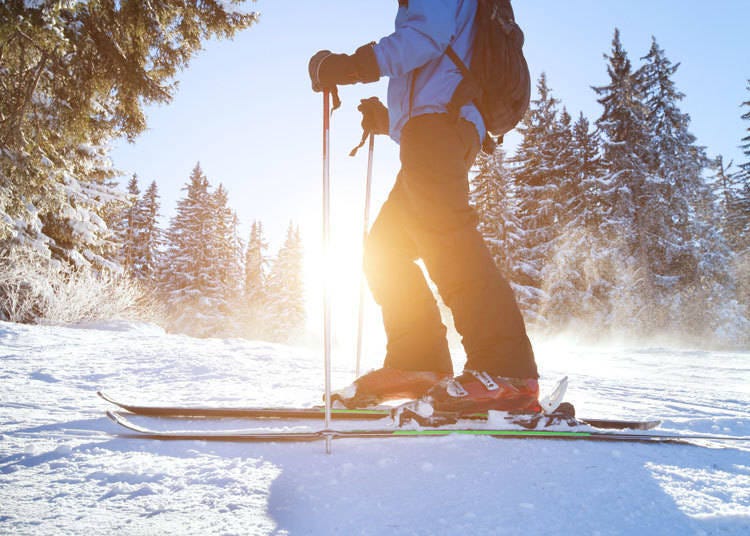
Also known as the Swiss army knife of skis, the all-mountain ski is available in the flavors of telemark and backcountry, although they are most commonly used in combination with powder skis.
・Telemark skis
Free heel design where the heel is not connected to the ski board is the hallmark of Telemark skis, which require a unique set of skiing techniques to master. Simply attach a Telemark ski binding to the ski board and you'll be able to enjoy a very different kind of snow activity!
・Backcountry skis
Used for off-piste skiing on snowy mountains and such, some backcountry skis are specialized models with holes and grooves or come outfitted with seals on their tips and tails, though the standard models generally make use of powder skis. Different types of backcountry skis cater to different conditions. Get a pair that's good for both walking and skiing so as to be ready to face any terrain in your ski tour!
2) You can never know too much about snowboards!
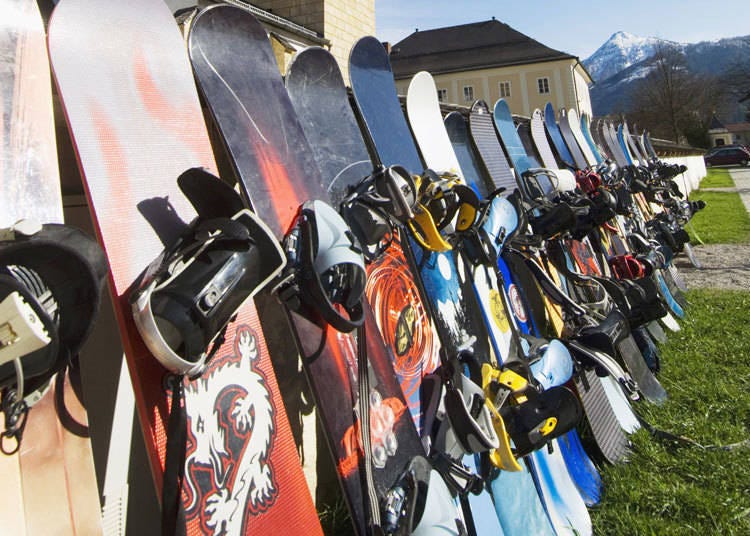
Now, let's take a closer look at snowboards! They are generally divided into three categories: Twin chips, directional, and directional twin snowboards.
●Twin chips
This refers to snowboards with similarly shaped nose and tail. The binding hole is in the middle of the board, but set up slightly nearer to the tail for riding.
●Directional
The binding hole is pre-built nearer to the tail. One of the characteristics of a directional board is that the nose and tail are shaped differently.
●Directional twin
These boards have a similarly-shaped nose and tail, but the binding hole is set up slightly nearer to the tail.
3) Off-season maintenance work
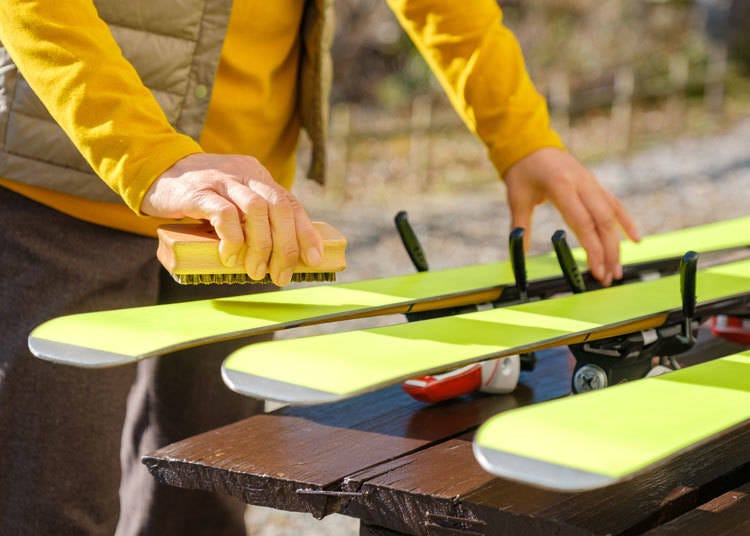
By maintaining your skis and snowboards properly, you'll be able to keep them in tip-top condition until the next season. Here are some things we highly recommend doing as part of your maintenance routine at the end of the season or during off-season.
●Beginner
The bare minimum you have to do for maintenance is to remove dirt and grime stuck on the soles of your skis and snowboards. Before starting, tie up the ski bindings with a thick rubber band to prevent them from shifting around, or remove the binding in the case of snowboards. Pour water all over the soles, then wipe the dirt and water away with a towel or rag. Apply some off-the-shelf remover solution to the soles as well to remove grease stains that water alone can't do much about.
●Intermediate
To prevent the soles from getting oxidized, which reduces equipment lifespan, they need to be waxed. First, use a scraper to scrape off the old wax, then use a remover solution to remove the dirt that has accumulated. For finer dirt that can't be removed by the scraper, try using a brush! To ensure that all dirt is properly removed, use a bronze brush, then wipe the brushed surface with a towel afterwards. Using a brush fluffs up the soles, so you'll need to wipe it with a special cloth purpose-built for polishing such surfaces. After thus refreshing the soles, apply some plain spray wax or solid wax on them to finish the anti-oxidizing treatment.
●Advanced
Here's a high-level maintenance tool that will help keep your skis and snowboards in near pristine condition at all times - hot wax! Scrape off dirt and grime as outlined in the intermediate section. Get some wax and run a specialized iron over it to soften it up before coating it all over the soles. Run the iron over the wax that's been coated over the soles to melt it completely. Put waxing paper on the soles, then melt some wax over the paper. Run the iron and waxing paper over the soles together to spread the wax out evenly across the entire surface. Do this for about five times per sole. Use a scraper to chip away excess wax and brush out the extra bits using a boar brush or nylon brush to finish the wax overlay treatment.
Applying a layer of base wax to the sole while the wax is still warm is one of the best ways to maintain them during off-season. Use the same waxing method as the wax overlay mentioned above. However, there's no need to scrape or brush away excess wax in this instance.
If you're not sure you can handle the maintenance well, you can always entrust your equipment to any professional tuning or service shops.
4) Sunscreen is a regular skier's best friend
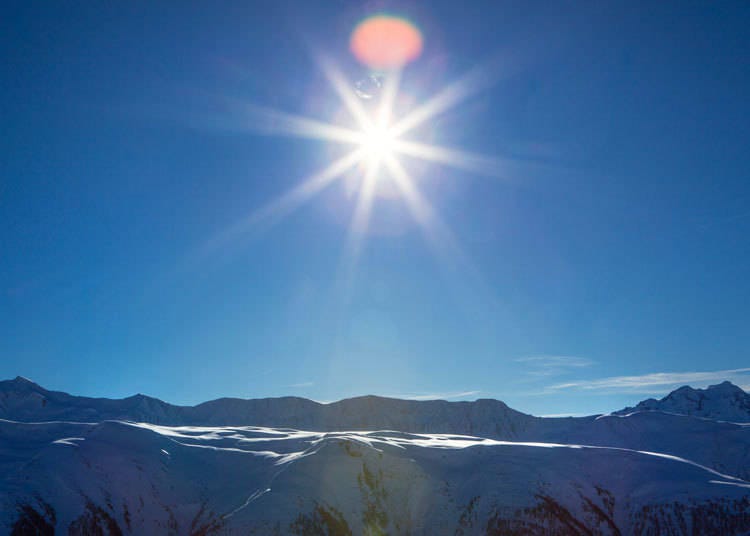
At the ski resort, you not only get exposed to direct sunlight, but UV rays reflected off the snow as well. As such, protecting yourself from getting sunburnt is a must. Don't forget to add moisturizing and cooling creams to your skin treatment routine for maximum protection!
●Sunburn prevention preparations
Apply a generous amount of sunscreen before starting your ski session and keep reapplying throughout the day, because even when you're not under direct sunlight, you're still being exposed to a lot of UV rays. Quickly reapply the sunscreen after perspiring or getting wet from the snow as well.
Dry skin is easily affected by harmful UV rays, so don't forget a good moisturizer. Before heading out for your ski session, go through your usual skincare routine and apply the sunscreen after putting on your lotions and creams so that it acts as a protective layer. You can put on your foundation and makeup on top of the sunscreen layer. The skin isn't the only thing you need to protect, of course. Remember to moisturize your lips and give it some protection from the sun as well with anti-UV lip balm.
●Cooling the skin down after sun exposure
Exposing the skin to the sun causes it to be somewhat inflamed, consider your skin will be lightly burned after each ski session. If you have a burn that actually stings, you're going to need a cooling gel or cream. Before that, though, cool down the swollen skin first using a towel wrapped in refrigerant or soaked in cold water. Sunburnt skin needs moisture too, so slap on a generous amount of mild lotion to keep the skin moisturized without irritating it further.
Getting to your ski resort of choice via tour buses or trains
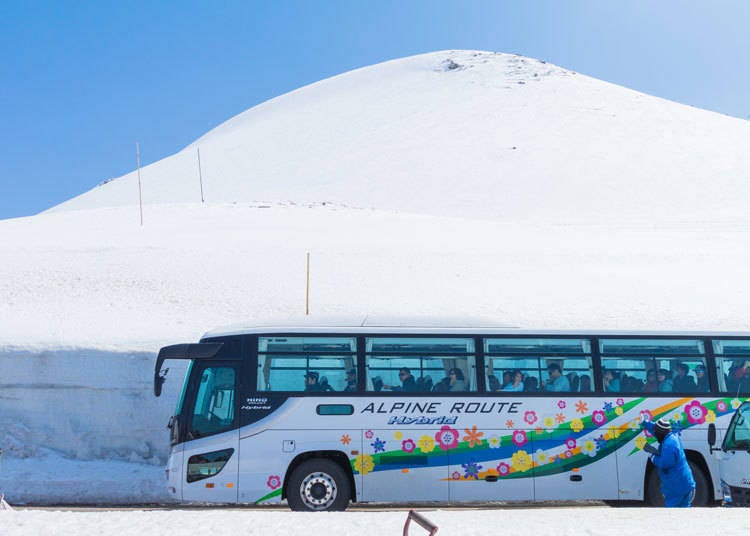
Renting a private car to get to a ski resort is perfectly viable, of course, but if you seldom drive in the snow and are not familiar with the dangers of such an environment, then it may be wiser to let the professionals take care of your transportation.
Even if you do get there in a private car without incident, all the tension from being on a constant lookout may render you too tired to enjoy any activities after the drive. Why not consider using a tour bus or train service instead?
You'll be at the destination ski resort before you realize it as you chat with your travel group about your ski trip in Japan. You can also make the traveling even less taxing both physically and mentally by opting to rent clothing and gear from the resort after arrival instead of lugging your own around.
●Tour buses
Tour companies will start scheduling tour buses to ski resorts once the ski season begins in earnest. Packages usually include the bus fare for a round trip along with a chair lift ticket for reasonable prices. Some companies offer one-night stay packages or day trip packages that set off at late night or early morning. There's even a day-before package that gets you to the resort one day before so that you can sleep and refresh yourself for the next day of activity. With so many plans and packages available, you're bound to find something that fits your itinerary.
●Trains
For trains, moving around on the Shinkansen bullet train is our recommendation. You may need to switch to a local bus to get to the ski resort from their nearest station, but most resorts have shuttle buses that will get you there with the least amount of fuss. Some ski resorts are strategically placed right beside a train station, so don't forget to check those out too!
English translation by: Huimin Pan
▼Early-bird lift tickets are recommended for winter skiing in Japan▼
- Area
*Prices and options mentioned are subject to change.
*Unless stated otherwise, all prices include tax.
Popular Tours & Activitiess
Recommended places for you
-

TOKYO SKYTREE®
Landmarks
Ryogoku / TOKYO SKYTREE(R)
-

Tokyo Metropolitan Government
Landmarks
Shinjuku
-

Tsukiji Outer Market
Old Towns (Shitamachi)
Tsukiji
-

Ueno Zoo (Ueno Zoological Gardens)
Zoos, Aquariums & Botanical Gardens
Ueno
-

Nezu Shrine
Shrines
Ueno
-

Ameyoko Shopping Street
Old Towns (Shitamachi)
Ueno
-

[12% OFF KKday Coupon] Mt. Fuji Autumn Leaves, Powder Snow & More! 15 Best Tours to Experience Japan in Fall & Winter
-
Ad

Okinawa Travel Troubles? Guide to the MCC Hotline for Illness and Weather Emergencies
-
Ad

Feeling Unwell While Traveling? HOTEL de DOCTOR 24 is Japan's Sole 24-Hour Online Medical Consultation Service
-

Autumn in Japan 2025: Fall Foliage Forecast & Where to Enjoy the Colorful Leaves (+Tour Info)
-

Half-Day Getaway from Tokyo: Cherry Blossoms, Local Culture and Samurai Vibes at Odawara Castle
-
Ad

A Tokyo Souvenir with Soul: The Handcrafted Leather of Bunkoya Oozeki
Inspiration for Accommodations
-

Enjoy Mt. Fuji from the Comfort of Your Room! Recommended Ryokan with Mt. Fuji View
-

Stay Near the Cherry Blossoms! Hotels for Cherry Blossom Viewing in Tokyo
-

Family-Friendly Hotels with Free Shuttle to Disneyland: Convenient Access for a Magical Stay
-

Top Ranked Hakone Hotels with Mt. Fuji View: Enjoy Stunning Scenery from Your Private Space
-

Convenient Tokyo Hotels with Airport Shuttle: Ideal for Families and Heavy Luggage
-

Stunning Tokyo Tower View Hotels: Enjoy Spectacular Scenery from Your Private Space
-

Convenient Asakusa Hotels with Kitchens: Ideal for Extended Family Visits
-

Experience Luxury: Hakone's 10 Best Five-Star Accommodations
-

Enjoy Mt. Fuji Autumn Leaves! Top Hotels Near the Popular Autumn Leaves Corridor
-

Experience Hakone Fall Foliage from Your Room with Stunning Views
-

Japan’s Unique Campus Festivals: Unwinding at Two Prestigious Universities in Tokyo!
-

Meiji Shrine (Meiji Jingu): Exploring the Sacred Sanctuary of Peace in Bustling Tokyo
-

Conveniently Located! 10 Best Ueno Hotels For an Unforgettable Tokyo Experience
-

Ikebukuro Station Area Guide: Top 15 Spots When You Escape the Station's Maze!
-

Super Mario Event at 7-Eleven Japan is Happening Now! What Did the LIVE JAPAN Team Buy?
-

8 Unfamiliar (But Totally Normal) Customs in Japan!
- #best ramen tokyo
- #what to buy in ameyoko
- #what to bring to japan
- #new years in tokyo
- #best izakaya shinjuku
- #things to do tokyo
- #japanese nail trends
- #what to do in odaiba
- #onsen tattoo friendly tokyo
- #daiso
- #best sushi ginza
- #japanese convenience store snacks
- #best yakiniku shibuya
- #japanese fashion culture
- #best japanese soft drinks












